
|
|
|
|
 |
|
Home Site Search Contact Us Subscribe
|
|
|
|
Found in Space: Griffith Observatory's New Exhibitions by C&G Partners, with Pfeiffer Partners and Levin & Associates Architects
Los Angeles, California: Innovative exhibits for an iconic institution are designed to build an appetite for discovery. By ArchNewsNow November 3, 2006 With its reopening on November 3, 2006, the newly restored
and expanded Griffith Observatory, an
iconic Los Angeles landmark on the southern slope of Mt. Hollywood, sets the
stage for an ambitious exhibit program conceived and designed by C&G
Partners of New York. The C&G design team worked very closely with the
architectural team of Los Angeles-based Pfeiffer Partners and Levin &
Associates Architects to integrate the exhibits and the architecture. The $93 million project includes the restoration of the
27,000-square-foot historic building and a new 66,000-square-foot, below-grade
expansion, which increases exhibit space from 5,000 to 16,000 square feet. Each
major zone of the observatory illuminates an aspect of astronomical
observation, actively involving visitors with informal learning environments,
participatory opportunities, interactive displays, and live presentations. While astronomy is rich with events and discoveries, turning
such technical and intangible content into dynamic and engaging experiences
required new approaches beyond the usual bounds of ideas-based exhibitions.
“With modern astronomy, the discoveries are largely digital and either so
minute or so vast that translating them into an experience for the public
required an exploration of its own,” explains Jonathan Alger, a founding
partner of C&G Partners and leader of the Griffith Observatory project
team. “We conceived of the exhibits as user-friendly tools to engage visitors
in layers of learning and use dramatic scale, technology, and inventiveness to
provoke wonder and curiosity. We wanted visitors to leave not just with facts
and figures, but with an appetite for discovery.” Sparking the Imagination C&G Partners also collaborated with a team of
professional astronomers, educators, and other specialists to develop
experiences that give meaning and context to the most common visitor inquiries
– from basic astronomical concepts to recent discoveries – while also conveying
the universe’s inherent awe and mystery. Offering more than 60 different
experiences, the exhibits set a new benchmark for using media and technology to
connect visitors to the universe. "The awe-inspiring vastness of the sky
is the one thing that all of us have in common.” says Alger. “The experiences
we created tap into this unifying theme and inspire visitors to see the sky
through new eyes. We want them to get as excited about planets, stars, and
galaxies as the astronomers are.” The exhibits cover all of the basics of astronomy – from
moon phases and tides to galaxies and red giants – as well as our evolving
relationship with the stars. Each wing of the historic building focuses on astronomical
observation from an Earth-based perspective. The Hall of the Eye demonstrates
how our understanding of the nature of the universe continually evolves as our
powers of observation become more powerful and precise. Cutting-edge animated
models show California Native Americans, Romans, early navigators, Andean
farmers, and early European astronomers using the sky to plan civilizations
while an interactive, eight-foot wide, luminous recreation of the Milky Way
allows visitors to investigate the galaxy up close. In the opposite wing, the Hall of the Sky presents how the
most fundamental things we encounter every day – moon phases, seasons,
eclipses, and tides – are astronomical events resulting from the eternal,
clock-like motions of the Earth, Moon, and Sun. Here, visitors will also find
an eight-foot-high interactive periodic table revealing that all of the
elements present in the human body were originally forged inside stars. Meanwhile, in the vast new underground spaces, such as the
Richard and Lois Gunther Depths of Space gallery, visitor perspective shifts
from the earth out to the open reaches of space, an experience of cosmic scale
informed by the discoveries made possible by recent space travel. Here,
visitors encounter a giant scale model of the solar system based on the latest
astronomical images. Most notable among the new exhibits is the Big Picture, the
largest astronomical image in the world. Made of solid porcelain enamel, the
152-foot-long by 20-foot-high installation magnifies real research imagery to
reveal that even a tiny fraction of the night sky contains literally millions
of stars, galaxies, pulsars, black holes, and other mysteries of space. Bringing a Historic Institution into the Future C&G Partners planned the exhibitions in the spirit of
Griffith J. Griffith, the mining millionaire and astronomy enthusiast who
endowed the observatory and donated the land for Griffith Park. After looking
through the telescope at the Mount Wilson Observatory in Pasadena, California,
Griffith said, “Man’s sense of values ought to be revised. If all mankind could
look through that telescope, it would change the world.” He envisioned a major
public observatory where the people of Los Angeles could be transformed by
experiencing the marvels of the night sky. Completed in 1935, the iconic original building was very
much a product of its time. “The simple beauty of the original building’s
structure and materials called for a light touch,” says Alger. “We designed the
experiences in the existing historic spaces to appear physically light and to
reinforce the building’s symmetry. At the same time, we used a contemporary
visual language of glass, metal, and deep color to create a bridge to the
observatory’s future.” Details like bronze balustrades and exaggerated
dimensional letters in the exhibition program further underscore this link between
past and present. The exhibits celebrate the observatory’s rich history while
also celebrating the advances of modern astronomy. Treasured elements of the
original collection—the Foucault pendulum, Hugo Ballin murals, and Tesla coil,
among others—were each restored, and a new exhibit was created to recognize the
vision of the observatory’s founder. More than 70 years later, Griffith’s
inspiration resonates still as his observatory prepares to resume its mission
of inviting visitors from Los Angeles and around the world to explore the
universe. The expansion also
includes the 200-seat Leonard Nimoy Event Horizon multi-media theater, the Café
at the End of the Universe, and Stellar Emporium gift shop and bookstore. The
Observatory – a registered City of Los Angeles Cultural Landmark and listed on
the California Register of Historic Places – is free to the public – though all
visitors must have a timed-entry reservation and shuttle ticket to visit the
Observatory during the reopening period. Project Credits Architect: Pfeiffer Partners Associate Architect: Levin &
Associates Architects Exhibit Design: C&G Partners LLC Exhibit General Contractor: Maltbie,
Inc. Construction Contractor: S. J. Amoroso
Construction Company Construction Management: Los Angeles
Department of Public Works Project Management, Building Operation:
Los Angeles Department of Recreation and Parks Star Projector: Carl Zeiss Jena GmbH Digital Laser Projectors: Evans &
Sutherland Computer Corporation Samuel Oschin Planetarium Dome: Spitz,
Inc. New York City-based C&G Partners
creates exhibitions, graphics, interactive projects, wayfinding, and identities
for clients of all kinds. The multidisciplinary team has been planning,
designing, and creating all of the new visitor experiences at Griffith
Observatory since August 2000; early work on the project was done by the same
team while at Chermayeff & Geismar Inc., the predecessor firm of C&G
Partners. Current clients include TimeWarner, Nasdaq, the Federal Reserve Bank,
the Holocaust Museum, the National Parks of New York Harbor, the National
Oceanographic & Atmospheric Administration, and the World Trade Center
Memorial Foundation. Pfeiffer Partners
is an award winning architectural, interior design, and planning firm with
offices in Los Angeles and New York City.
The practice emphasizes civic, cultural, and educational work and
encompasses planning and urban design, and historic renovation and adaptive
reuse. Founded in 1980, Los Angeles-based Levin & Associates Architects
is well known for its historic preservation work on some of Los Angeles's
notable landmarks. The firm’s scope of work includes urban design and master
planning, large-scale renovation and adaptive re-use of historic buildings, and
the design of new institutional, commercial, and multi-family housing
facilities. |
(click on pictures to enlarge) 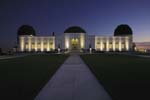 (Justin Donais / Courtesy of Friends of the Observatory) Restored to its original grandeur, Griffith Observatory tripled its exhibition space with a below grade expansion underneath the front lawn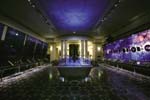 (Justin Donais / Courtesy of Friends of the Observatory) New exhibitions in the historic spaces engage the architecture and reinforce existing building symmetries (Justin Donais / Courtesy of Friends of the Observatory) A monumental scale model of the planets defines one edge of the new underground exhibit space. Cantilevered supports hold up carefully hand-painted planet models at their relative angles of axial tilt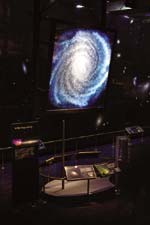 (Justin Donais / Courtesy of Friends of the Observatory) Experiences in the large new underground halls use a more free-form geometry and are meant to float within the dark interior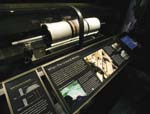 (Justin Donais / Courtesy of Friends of the Observatory) The details of the exhibition infrastructure take their cues from existing historic elements in the project, but use them in a more modern way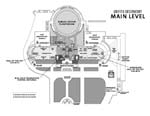 (Courtesy of Friends of the Observatory) Plan of the historic building and below-grade expansion. |
© 2006 ArchNewsNow.com